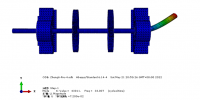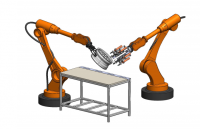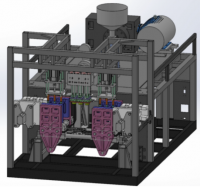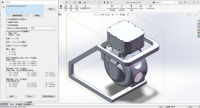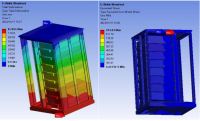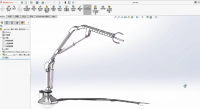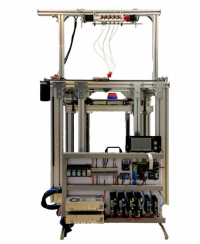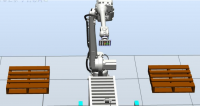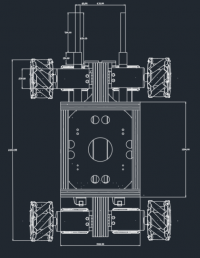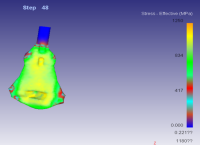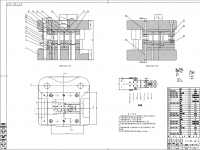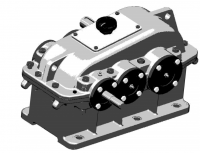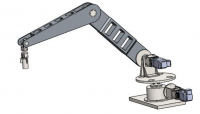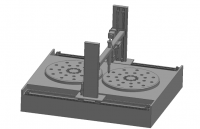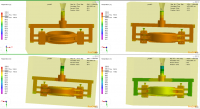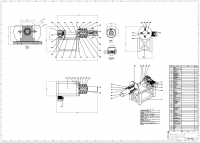轴系-转子系统主动减振基座结构设计与动力学有限元及模态分析
摘要 轴承-转子系统是机械中比较重要的一个部件,但是在旋转过程中会有振动,其振动通过轴承基座来传递到结构,引起主体结构振动,对设备的正常运转造成了严重的影响。传统振动抑制方法大都是采用被动减振的方法来实现的,即通常在轴系转子平台和地基之间安装隔振器。但此种方法通常对中、高频振动有效。对于船舶轴系-转子平台,由于其转速不高,振动大多集中在低频,仅用被动方法无法抑制低频振动,需要引入主动减振方法来实现低频振动的抑制。
本文为了给船舶轴系振动抑制提供方法验证实验平台,设计了一款轴系-转子模拟实验台,模拟船舶轴系运行状态。首先依据转速要求和所承受的扭矩大小,通过计算分析,确定轴系-转子主要结构设计尺寸。依据扭矩大小对驱动电机进行了恰当选型。之后设计了包含转轴、齿轮盘、轴承及轴承基座、驱动电机及加载电机的轴系转子模拟实验平台。为了方便模拟轴系转子所受的静态外激励,设计了一款径向加载装置,该装置能够对轴施加径向方向,可变的静力。为了模拟轴系-转子平台所受到的动态外激励,设计定型了动态力加载电机,可以在端部给轴系施加频率可变的正弦力。
基于所设计的轴系-转子平台,在轴系-转子基座和地基之间,依据平台重量,对被动减振基座进行了选型,设计了方便安装的被动减振基座。为了实现低频振动抑制,在轴承基座内部设计安装了三个方向的作动器,该设计可为主动振动抑制提供有效作动器,为后续实现轴系-转子在宽频段的振动抑制提供支撑。为了考核主动基座的振动特性,基于所设计的主动基座,对其进行了模态分析,分析结果表明主动基座固有频率远高于轴系-转子的前几阶固有频率,不会增加整体低频振动风险。
为了充分掌握轴系-转子系统的振动特性,分别对该结构中的轴、齿轮传动主要部件进行了有限元分析。基于有限元获得的转轴的扭振频率,计算得到轴系-转子的临界转速,并与理论计算结果进行对比,验证了有限元建模的正确性。之后对整体轴系-转子平台进行了有限元分析。通过这些结果,获得轴系-转子中主要构件的模态特性和整体的模态特性,对比分析了部件及所施加的约束对整体轴系-转子振动模态的影响。这些结果能为后续主动控制力的施加提供有力的参考。
关键词:轴系-转子、被动减振基座、主动减振基座、临界转速、模态分析
Structural Design and dynamic analysis of active vibration absorber pedestal for bearing-rotor system
Abstract Bearing-rotor system is one of the most important parts in machinery, but there will be vibration in the course of rotation, and its vibration will be transmitted to the structure through the bearing base, causing the vibration of the main structure, the normal operation of the equipment caused a serious impact. Traditional vibration suppression methods are mostly implemented by passive vibration reduction, that is, vibration isolators are usually installed between the rotor platform and the foundation. But this method is usually effective for medium and high frequency vibration. For the shafting-rotor platform, because of its low speed and low frequency vibration, the passive method can not suppress the low frequency vibration, so it is necessary to introduce the active vibration reduction method to realize the low frequency vibration suppression.
In this paper, a shafting-rotor Simulation test-bed is designed to provide experimental platform for ship shafting vibration suppression. Firstly, according to the requirement of rotational speed and the magnitude of Torque, the design dimensions of the main structure of shafting-rotor are determined through calculation and analysis. According to the Torque size of the drive motor for the appropriate selection. Then, a rotor simulation experiment platform including rotor, gear disc, bearing and bearing base, driving motor and loading motor is designed. In order to simulate the static external excitation of the rotor system, a radial loading device is designed, which can apply a radial and variable static force to the shaft. In order to simulate the external dynamic excitation of the shafting-rotor platform, a dynamic force loading motor is designed, which can exert sinusoidal force with variable frequency at the end of the shafting.
Based on the designed shafting-rotor platform, between the shafting-rotor base and the foundation, according to the weight of the platform, the passive damping base is selected, and the convenient installation of the passive damping base is designed. In order to realize the low frequency vibration suppression, an actuator with three directions is designed and installed in the bearing base, which can provide an effective actuator for the active vibration suppression, it provides support for the following realization of shafting-rotor vibration suppression in a wide frequency band. In order to examine the vibration characteristics of the active base, the modal analysis of the active base is carried out based on the designed active base, will Not increase the overall risk of low-frequency vibration.
In order to fully grasp the vibration characteristics of shaft-rotor system, the main parts of shaft and gear transmission in this structure are analyzed by finite element method. Based on the torsional vibration frequency of rotor obtained by finite element method, the critical speed of shaft-rotor is calculated and compared with the theoretical results, which verifies the correctness of finite element modeling. Then the finite element analysis of the whole shafting-rotor platform is carried out. Based on these results, the modal characteristics of the main components and the whole shafting-rotor are obtained, and the influence of the components and the constraints on the vibration modes of the whole shafting-rotor is analyzed. These results can provide a strong reference for the subsequent active control force.
Key words: Shafting-rotor、Passive damping base、Active damping base、Critical speed、Modal Analysis
目 录
第一章 绪论 1
1.1选题的背景意义 1
1.2 国内外的研究状况 1
1.3 研究的主要内容及方法 2
1.3.1 研究的主要内容 2
1.3.2 研究的方法 2
第二章 轴系-转子机械结构设计 3
2.1 轴系齿轮盘系统的结构设计 3
2.1.1轴系-转子设计要求及轴径计算 3
2.1.2齿轮盘结构设计与装配设计 4
2.1.3转轴临界转速的计算 6
2.2 滚动轴承及其基座的结构设计与计算 6
2.3 增速齿轮箱的结构设计及电机的选型 8
2.3.1 电动机的选型 8
2.3.2 增速齿轮箱的结构设计 10
2.4径向加载装置的结构设计 12
2.5本章小结 13
第三章 被动减振基座设计 15
3.1 被动减振原理 15
3.2 设备振动常见类型 16
3.3 被动减振基座选型 18
3.4 被动减振基座结构设计 19
3.5 被动减振基座的安装 21
3.6 本章小结 21
第四章 主动基座结构设计及动力学分析 21
4.1 主动基座的特性以及选型 22
4.2 作动器三维模型设计 23
4.3 作动器装配设计 24
4.4 主动基座有限元分析 26
4.5 本章小结 27
第五章 轴系-转子系统动力学分析 28
5.1 轴的有限元分析 28
5.2 齿轮传动的有限元分析 30
5.2 轴系-转子系统的模态分析 33
5.2.1 有限元三维模型建立 33
5.2.2 加载和约束设置 35
5.2.3 模态计算结果 36
5.3 本章小结 38
第六章 工作总结 40
致谢 41
参考文献 42
第一章 绪论
1.1选题的背景意义
轴承行业—转子机构是回转设备中最关键的部分,其震动通过轴承基础直接影响到设备的自然本体,从而引起设备内部的震动,也因此严重干扰了机器设备的正常工作,但是设备的内部震动却是干扰使用寿命的最重要原因之一。又例如舰船的推进装置,由于的震动会通过轴承行业的机械地基直接影响到船舶,从而引起了船体的二次震动以及在水下的噪声传播,从而伴随的影响了舰船的稳定性。作为主要的推理装置,作用是联接主机和推进器。严重的轴系震动可引起轴系的非正常损坏或出现破坏,对船舶产生危害。所以,轴系震动是损害轴系的主要原因,人们必须予以关注。目前广泛应用于径向轴承基座的减振措施为敷设约束阻尼层,轴系台架安装隔振器,这是一种被动减振方法,其仅对中高频振动有效,无法控制低频振动。主动减振基座可通过自适应主动力的调节来减小轴系-转子系统的振动,改善轴系-转子的运行状态。
1.2 国内外的研究状况
为进一步提高滚动时轴承转子的工作效率,国内外研究者们在轴系的振动分析及其振动计算等方面,开展了大量的研究工作。例如,人研究了在不同推进系统工作状态下的轴系激励以及驱动力的计算公式,以及根据数值的模拟结果和实验中的测试数据,探讨了舰船在大载荷飞行时的轴系震动特征。此外人还整理了国外的有关舰船推进轴系纵向振动理论及其控制方法的研究进展,较为重点的研究了轴系纵向震动形成的原因,以及轴系纵向减振的方法及其相应的实验研究中的现在情况。在转子优化的模块的设计中,Ebaid运非线性优化的涡轮转子的技术进行了全部的设计,计算了主要的尺寸大小,并提到到了机械特性,并且进行热应力的有限元模态分析,在建转子动力的模型那一方面,Lee建立了转子广泛的有限元分析,对于模型中也是引入了相对的位移,精准定位预测了轴系-转子系统。结果分析说明,当有冲击力的时候,瞬态模型的振动响应要比传统单个盘的转子还要低。也根据分析的结果在比较有限元的数值进行仿真和实验,并且研究了轴系纵一扭耦合的振动以及横一扭耦合的振动现象,并根据这种现象提出了一种比较合理的刚度系数的计算方法,可以给轴系的振动提供一种支撑理论。
上个世纪60年代初,发现了采用直线校中的方式安装的轴系,大多数工作不能达到最佳状态,甚至可能会产生负面的破坏。之后,逐渐就有了按轴承允许负荷校中、合理校中、和动态校中等轴系校中的方法。
1.3 研究的主要内容及方法
1.3.1 研究的主要内容
(1)依据转速要求和最大扭矩设计要求,设计一款轴系转子平台,模拟船舶系统轴系推进系统。
(2)依据轴系-转子平台各部分质量,选型设计被动减振基座;
(3)依据轴系-转子平台在轴承处易于发生不平衡振动问题,在轴承基座处设计安装作动器,获得主动减振基座设计方法,并对主动减振基座进行振动特性分析;
(4)采用有限元分析方法,计算轴系转子中主要部件的振动特性和轴系-转子整体平台的振动特性,分析各个部件及约束、载荷对轴系-转子平台固有振动特性的影响。
1.3.2 研究的方法
(1)运用机械设计理论所学知识,并通过查阅旋转机械轴系结构基座设计准则,采用二维和三维设计软件,给出主动基座设计方法,并联合轴系-转子给出整套结构设计方案。
(2)利用有限元理论,基于有限元软件,对所设计的主动基座进行动力学仿真。将基座装配在轴系-转子平台,对整套系统进行动力学仿真,并分析其动力学特性。
参考文献
[1].曾凡明,吴家明,庞之洋. 舰船动力装置原理[M]. 北京:国防工业出版社,2009.
[2].陈国钧,曾凡明. 现代舰船轮机工程[M]. 长沙:国防科技大学出版社,2001.
[3].孔晓丽,王欢,乔红宇. 冰区航行船舶推进轴系扭转振动研究[J]. 船舶工程,2018,40(8):14-19.
[4].肖能齐,周瑞平,徐翔,等. 冰载荷电力推进轴系扭转振动研究[J]. 船舶力学,2018,22(5):603-614.
[5].Xiao N Q,Zhou R P,Xu X. Vibration of diesel-electric hybrid propulsion system with nonlinear component[J]. Journal of Vibration and Control,2018,24(22):5353-5365.
[6].赵耀,张赣波,李良伟. 船舶推进轴系纵向振动及其控制技术研究进展[J]. 中国造船,2011,52(4):259-269.
[7].黄志伟. 推进轴系纵向振动主动控制技术综述[J]. 舰船科学技术,2018,40(11):1-8.
[8]. Huang Q W,Yan X P,Wang Y K,et al. Numerical modeling and experimental analysis on coupled torsional-longitudinal vibrations of a ship's propeller shaft[J]. Ocean Engineering,2017,136:272-282.
[9]. Huang Q W,Yan X P,Zhang C,et al. Coupled trans⁃ verse and torsional vibrations of the marine propeller shaft with multiple impact factors[J]. Ocean Engi⁃ neering,2019,178:48-58.
[10].徐翔. 船舶复杂推进轴系耦合振动理论及试验研究[M]. 武汉:武汉理工大学,2012.
[11]. Mann G. Analysis of shafting problems using fair curve alignment theory[J]. Naval Engineers Journal,1965,77(1):117-133.
[12]. Mann G. Shipyard alignment of propulsion shafting using fair curve alignment theory[J]. Naval Engineers Journal,1965,77(4):651-659.
[13].曹学涛,刘玉君,李艳君,等. 基于ANSYS的船舶轴系校中的双向优化研究[J]. 造船技术, 2009(3): 11-15.
[14].曹学涛. 船舶轴系校中的双向优化研究[J]. 大连: 大连理工大学,2008.
[15].王贤烽,林青,周继良. 船舶轴系轴承位置的双向优化研究[J]. 造船技术,1993(8):23-26,7.
[16].路明,张超,王军,等. 基于有限元方法的发动机主轴承座及主轴承盖设计[J]. 机械,2015,42(9):53-57.
[17].安学玲. 轴承座加工工艺改进[J]. 煤矿机械,2018,39(2):89-90.
[18].张宇,陈予恕,毕勤胜. 转子-轴承-基础非线性动力学研究[J]. 振动工程学报,1998,11(1):24-30.
[19].包家汉,徐培民,余晓流,等. 柔体机构有限元模态分析中铰链联接的处理[J]. 机械设计, 2007, 24(3):13-15.
[20].张伟峰. 基于轴承座的数控加工工艺设计与处理[J]. 机械,2012,39(2):64-66.



